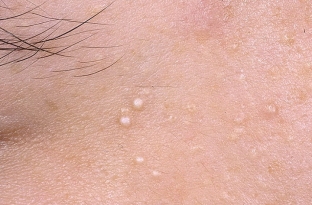Skin defects appear in different forms: redness, sagging, wrinkles, blemishes, pimples, blackheads, etc. Among them, there are also milia, which are also called millet, white pimples and retention miliary cysts. Such formations are most often found under the eyes and on the upper eyelid. Less commonly, they can be found on the cheeks, forehead, neck, cheekbones, or not on the face at all.
What are milia
Miliums – these are white or yellowish formations protruding above the surface of the skin, ranging in size from half a millimeter to 2-3 millimeters. They do not cause itching or pain. Milia often go away on their own, but in some cases they can remain on the skin for several years.
It is also important to know that the cystic wall of milia consists of epithelial cells, and the cyst capsule itself – from keratinized epithelial cells (keratin accumulations), therefore milia are not related to the sebaceous glands, despite the fact that a small amount of fat can be observed in their composition.
It is assumed that milia on the face (and not only) are the result of accelerated cell division of the upper layer of the skin, accompanied by delayed exfoliation. This is important to consider when removing milia.
Miliums on the face: causes of occurrence
Unambiguous causes of milia have not been established. Presumably, milia can appear as a result of a violation of the development of skin layers or their damage as a result of inflammation or trauma. Also, the following factors can contribute to the appearance of milia on the face and other parts of the body:
- heredity;
- hormonal imbalance;
- metabolic disorder;
- problems of the digestive organs;
- Vitamin A deficiency;
- sun exposure;
- cosmetics.

Milium removal methods
As a rule, squeezing out milia, like ordinary acne, will not work, because they have a different structure, composition and origin. Therefore, sometimes external preparations with exfoliating functions are used to remove milia. However, such remedies are ineffective, so milia that do not go away on their own are treated in the following ways:
Curettage
This mechanical method of removing milia is piercing and squeezing out the cyst. You can also use the curette – a special spoon-shaped tool that removes the milia from the skin along with the capsule.
Electrocoagulation
In this case, a high-frequency electric current is used to remove milia, which allows you to act on individual problem areas without damaging the adjacent tissues. Since the current cauterizes the milia, as a result of its exposure, a crust is formed, which must subsequently be treated with antiseptic agents (about a week). In addition, exposure to current can cause scarring.
Millia removal with laser
Carbon dioxide laser (CO2 laser) is used for high-precision layer-by-layer removal of unwanted formations on the skin without affecting healthy tissues. Lasers are the most reliable and convenient way to remove milia.
In any case, if you are concerned about milia, Estet-portal recommends contacting a specialist who can, firstly, confirm that the formations on your skin – it's really milia, and secondly, to recommend you a suitable way to remove milia and prevent their further occurrence.
To keep your face in good shape, a three-minute exercise for lips and cheeks will help you:
Stay beautiful and healthy with Estet-portal!






Add a comment